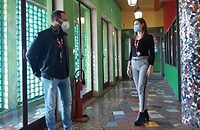Tech company Unacast is using smartphone data to see where people are taking social distancing instructions seriously.
The Norwegian company released a study ranking all 50 states and the District of Columbia on a Social Distancing Scoreboard.
The company explored:
- People dwelling at home vs dwelling outside their homes (a proxy for how good an area is at "shelter-in-place" behavior)
- Changes in average time spent in and around home, aggregated over time (a proxy for how much time people spend at home versus other venues)
- Change in dispersion of activity clusters, or how many people no longer gathered in the same location at the same time (a proxy for change in number of encounters)
- Change in average distance traveled
Overall, the study found that since February 28, Americans have reduced their mobility by nearly 40 percent. D.C. topped the list, reducing its average mobility by 60 percent, followed by Alaska, Nevada, New Jersey and Rhode Island, which all earned an A.
Wyoming – the only state to receive an F – ranked 51st, with no change in average mobility. The bottom five states were Oregon, New Mexico, Idaho and Montana.
The scoreboard is updated daily.
The company said in a blog post that "Travel distance is one aspect, but of course people can travel far without meeting a soul or travel 50 feet and end up in a crowd — so we know that the real world picture can be quite complex. Changing behavior will trigger adjustments in our data strategy. That's why, post launch, we will be continuously working to improve our social distancing models."
The post added that Unacast is in the process of understanding the best way to add layers that capture more of the complexity of social distancing: exploring how a change in the number of encounters for a given area, as well as a change in the number of locations visited, contribute to an area's social distancing score. Since many important social distancing metrics can be derived from an accurate understanding of residences, it is also dedicating resources to adjusting home assignment algorithms so that they can better identify new common evening locations.



